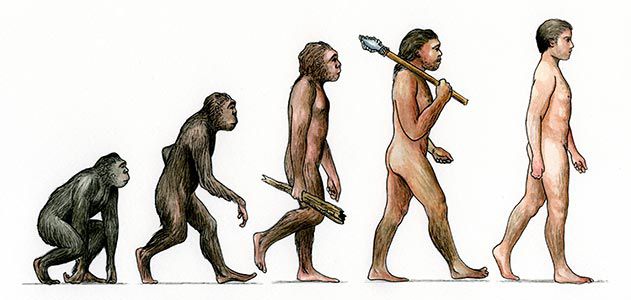“Natural Selection” Still at Play in Humans
Biological evolution, simply put, is descent with modification. This definition encompasses small-scale evolution (changes in gene frequency in a population from one generation to the next) and large-scale evolution (the descent of different species from a common ancestor over many generations). Biological evolution is not simply a matter of change over time. Lots of things change over time: trees lose their leaves, mountain ranges rise and erode, but they aren’t examples of biological evolution because they don’t involve descent through genetic inheritance.
The central idea of biological evolution is that all life on Earth shares a common ancestor, just as you and your cousins share a common grandmother.
Through the process of descent with modification, the common ancestor of life on Earth gave rise to the fantastic diversity that we see documented in the fossil record and around us today. Evolution means that we’re all distant cousins: humans and oak trees, hummingbirds and whales.
And now, an international team of scientists has detected significant signatures of natural selection in the human genome that influence traits associated with fertility and heart function.
A team, led by Professor Jian Yang and Dr Jian Zengfrom UQ’s Institute for Molecular Bioscience and Queensland Brain Institute , developed a statistical method to examine the effect of DNA mutations, or variants, on genetic architecture.
“In natural selection, or ‘survival of the fittest’, characteristics that improve survival are more likely to be passed on to the next generation,” Professor Yang said. “The opposite also occurs, when DNA mutations with a detrimental effect on fitness are less likely to be passed on, by a process called negative selection.
Jian Yang, Jian Zeng and a team of researchers from the university’s Institute for Molecular Bioscience and Queensland Brain Institute studied the genomic data from 126,545 individuals in the UK Biobank, an anonymised health database in the UK.
They closely examined 28 complex traits, such as heel bone mineral density, male pattern baldness, BMI, female age at first menstruation and menopause, female age when giving live birth for the first time, grip strength, and hip-to-waist ratio.
By studying the genes associated with these traits in individuals at different ages, it’s possible to see differences between generations.
The researchers said they found evidence of negative selection – the removal of deleterious gene variants – in several traits. And the strongest evidence was in traits related to cardiovascular function and reproductive function.
Professor Yang said the team found evidence of negative selection on DNA variants associated with a number of traits. “Among the strongest associations was with traits related to cardiovascular function, such as waist-to-hip ratio, with excess fat around the waist thought to increase the risk of heart disease and type 2 diabetes,” he said. Dr Zeng said the most significant negative selection of DNA mutations was related to reproductive function, such as age at menopause.
“We found genetic variants associated with fertility seem to have undergone the strongest selection compared to those associated with other traits, likely because of the strong correlation between fertility and genetic fitness,” Dr Zeng said. “Negative selection prevents ‘bad’ mutations from spreading through the population, meaning that common DNA variants are likely to have small or no effect on traits. This study will help us better understand the genetic basis of complex traits and inform the design of future experiments in complex traits and medical genomics.”






























